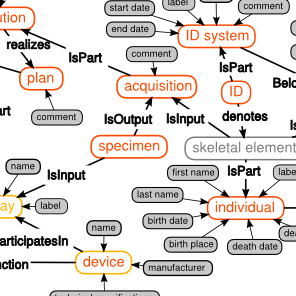
Semantic Modelling of Osteological Research Data
Making Research Explicit
© 2022. All rights reserved.
AnthroGraph is a research information system based the idea of semantic data modelling. It implements RDFBones and other ontologies covering research domains in biological anthropology and it can load all extensions written for these ontologies. AntroGraph is provided as open-source software for research institutions to install it on their own servers. Researchers working at these institutions can use it to create and manage highly annotated semantic research data and institutions can provide this service to external collaborators as well. AnthroGraph is designed for research in biological anthropology and can be further customised to suit the specific needs of research institutions and projects.
AnthroGraph is designed to help researchers in biological anthropology to produce and process research data coded according to the resource description framework (RDF). It behaves like a conventional (relational) data base application but produces data with a much higher information density. This basic functionality supports a number of processes in anthropological research.
Enter data during research – AnthroGraph provides forms based on subsequent stages of scientific investigations based on their study design. Researchers can leave notes with all data items they enter to provide additional information and to point out connections between items.
Prepare data for archival – AnthroGraph produces datasets that are well documented and highly annotated. This makes it possible to come back to them for further analysis even after longer periods of time. AnthroGraph datasets are also suitable for submission to contraction and funding authorities or for long-term storage in research data repositories.
AnthroGraph is built on the metaphactory framework and provided as open-source software. Institutions planning to adopt AnthroGraph will still have little problems in finding professional support for adopting the system to their own requirements. For now, AnthroGraph implements the RDFBones core ontology and is mainly oriented towards osteological research. This scope, however, can be widened to cover other areas of biological anthropology if needed.
Resarch and infrastructure institutions can install AnthroGraph on their own servers or with a provider and offer its use as a service to their own employees or external partners through a network, e. g. the internet. Within institutions, AnthroGraph can cover several areas of work. On the level of curation of skeletal materials it can be used to track material completeness and preservation through skeletal inventories and record measures relating to the curation of the material. On the level of research it supports investigations carried out on the material and records the resulting research data.
AnthroGraph can be employed in various research settings:
Research projects can use AnthroGraph to provide collaborators with a virtual work environment configured for the project’s study design. AnthroGraph collects contributions from project collaborators and can be used to provide resulting research data to selected audiences or to publish them online. Skeletal collections can use AnthroGraph to track research conducted on their collection material and to collect the resulting research data together with metadata about who conducted investigations and for what purposes. They can also track deterioration of the collection material through handling during investigations and sample-taking. Research institutions can use AnthroGraph to manage research data produced by their scientists. This is especially effective if research data are to be re-used in successive projects. Cultural heritage institutions can use AnthroGraph as a submission platform for osteological data from their own staff or from contracted osteologists. Here they can enforce their own standards and provide a virtual work environment supporting them. Do not hesitate to contact us if you think that AnthroGraph might help with your collection and research data management needs.